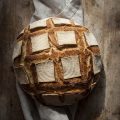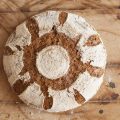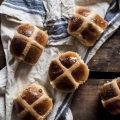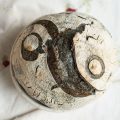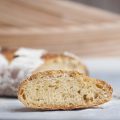Biting into a slice of freshly baked pumpernickel bread is a singular delight. With its rich brown color, sweet malty aroma, and hearty rye flavor, pumpernickel represents the deepest expression of traditional rye baking. Today, I’ll show you how to make pumpernickel bread and take you step-by-step through my favorite family recipe!
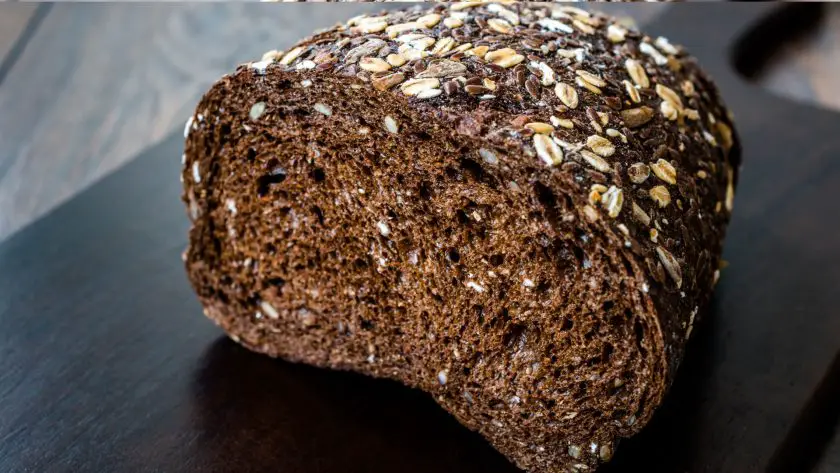
Table of Contents
- Ingredients
- Tools and Equipment
- Preparation Before Baking
- Baking Process
- Common Mistakes to Avoid
- Variations of Pumpernickel Bread
- Old World Charm: Artisanal Pumpernickel Bread
- How To Make Pumpernickel: FAQs
Ingredients
To make a delicious loaf of pumpernickel bread, you’ll need:
- 2 cups dark rye flour
- 1 cup all-purpose flour
- 1 packet (2 1/4 teaspoons) active dry yeast
- 1 tablespoon unsulphured molasses
- 1 teaspoon salt
- 1 1/3 cups warm water
- 2 tablespoons vegetable oil
- 2 tablespoons cocoa powder
- 1 tablespoon coffee grounds
- 1 teaspoon caraway seeds (optional)
Tips
- Seek out stone-ground whole grain rye for maximum nutrition and authentic hearty flavor. Schär and Hodgson Mill make great options.
- The all-purpose flour lightens up the dense rye texture. You can use white or wheat flour.
- Make sure the yeast is active and fresh for proper rising. Proof in 110°F water with a pinch of sugar before adding.
- Blackstrap molasses adds delightful bittersweetness. Substitute with dark brown sugar or maple syrup.
- The water should be 110-115°F to activate the yeast.
- The oil helps retain moisture and soften the crumb. Use olive or avocado oil.
- Dutch process cocoa amplifies the deep, dark color.
- Freshly ground coffee enhances the malty flavor.
- Toasted caraway seeds provide an authentic flair. Leave out if disliked.
Tools and Equipment
When it comes to pumpernickel bread, having the right tools and equipment on hand makes all the difference between a tasty artisan-style loaf and a dense, crumbling brick. As an enthusiastic home baker dedicated to mastering the craft of breadmaking, I’ve acquired an arsenal of essential baking gear over the years. Here’s an overview of the key tools and equipment needed to make a perfect pumpernickel:
- Mixing bowl – A large stainless steel or heatproof glass mixing bowl, around 4-5 quarts.
- Hand mixer or stand mixer – For thoroughly incorporating ingredients. The power of a stand mixer works best for dense doughs.
- Metal measuring cups and spoons – Durable and accurate for measuring all ingredients.
- Glass measuring cups – Clear cups with spouts work best for accurately measuring liquids.
- Cutting board – A good quality board for halving risen loaves.
- Bench scraper – Essential for portioning and handling dough.
- Sharp knife – For slashing and slicing finished loaves.
- Cast iron Dutch oven or ceramic baker – Traditional covered baking vessels that conduct heat evenly and retain moisture.
- Rimmed baking sheet – Catches any overflow from free-form loaves. Line with parchment paper.
- Standard gas or electric oven – Holds an even 300-350°F temperature. Convection ovens also work well.
- Oven with glass window – Allows monitoring of baking progress without losing heat.
And there you have the core essentials for equipping your kitchen to bake sensational sourdough pumpernickel loaves at home.
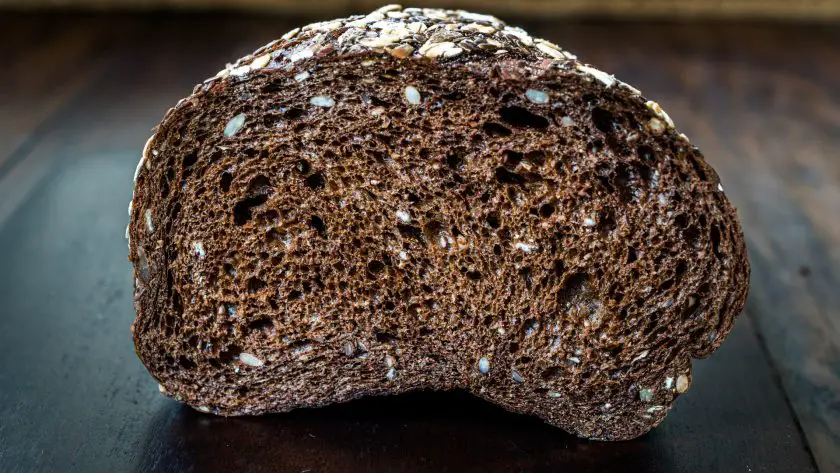
Preparation Before Baking
We’ll break down the step-by-step process to ensure your dough comes together perfectly before rising and baking. With a few essential techniques, you’ll turn out professional quality sourdough pumpernickel loaves from your kitchen.
1. Scaling and Measuring Ingredients
Accurately measuring all ingredients is crucial for nailing the right texture and flavor. Use metal or plastic measuring cups for the liquids and flour so you can level them off. Scoop the cocoa powder and yeast packets to ensure precise amounts. Don’t forget to proof the yeast first in 110°F water to verify viability before mixing the dough. Getting the proportions right from the start prevents overworking the dough later.
2. Mixing the Dough
With a big 4-5 quart stainless steel or glass mixing bowl and a heavy-duty stand mixer fitted with a dough hook attachment, you’ll get the power and space needed to properly knead. First mix together the dry ingredients – flour, sugar, yeast, salt, cocoa powder, and caraway seeds. Next slowly add in the wet ingredients – water, molasses, coffee, oil – while mixing on low speed until combined. Then knead for 5-7 minutes.
3. Kneading Technique
- As you knead, the dough will transition from shaggy and loose to smoother and more cohesive.
- Adjust hydration as needed by adding a bit more water or flour.
- Knead the dough by pressing into it with the heel of your hand and folding it over itself repeatedly.
- Use a light touch at first, then gradually increase pressure as the gluten develops.
- The kneading motion stretches and aligns the gluten strands to create an elastic network that can trap gases during fermentation.
- Knead for 5-10 minutes until the dough passes the windowpane test – stretch a small piece between your fingers to make a thin, translucent sheet without tearing.
- Keep your hands and working surface lightly floured to prevent sticking.
- Scrape the dough off the counter with a plastic scraper or bowl scraper as needed if it does start to stick.
- You’ll know the dough is ready when it is tacky, and supple, and springs back when pressed gently.
- Resist over-kneading when making pumpernickel bread which can cause the bread to turn out tough.
4. First Rise
Lightly grease a big bowl with oil then form the smooth dough into a ball and transfer seam-side down. Cover the bowl tightly with plastic wrap or a damp towel and let rise for 1-2 hours at room temperature, until doubled in bulk. Punch gently and shape it into a ball again for the second rise.
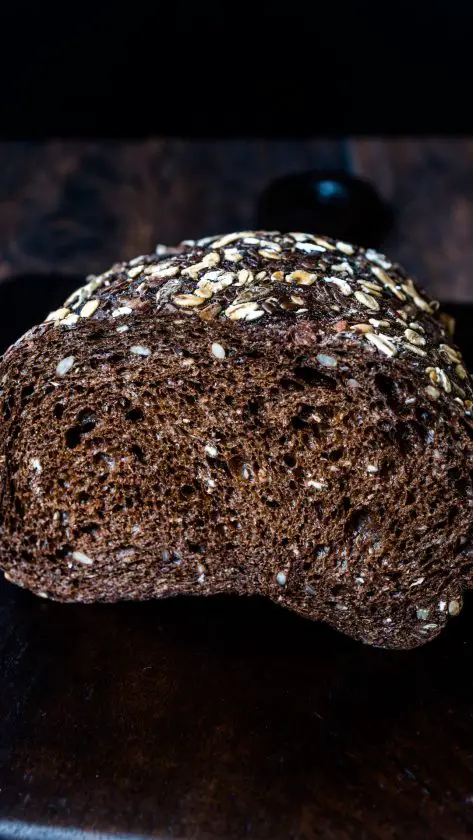
Baking Process
Preparing for Baking
- Place oven rack in center position in oven.
- Preheat oven to 350°F.
- Allow oven to fully preheat which takes approximately 15-20 minutes.
- Lightly dust a large sheet of parchment paper with flour.
- Gently turn the rounded ball of dough out onto the floured parchment paper.
- Position dough ball seam-side down in the center of the parchment paper.
- Make sure there is at least 2 inches of space between dough ball and edges of parchment to allow for rising.
- Score the dough. Take a serrated bread lame, very sharp knife, or razor blade.
- Make 4-5 long cuts across the top of dough ball about 1/4 to 1/2 inch deep. Cuts should go lengthwise across the dough Angling the cuts slightly allows the dough to open attractively during baking.
- Fill clean spray bottle with room temperature water.
- Have ready beside oven when placing bread into oven.
Baking Vessel Options
Selecting Baking Vessel:
- Choose a heavy, thick-walled Dutch oven, combo cooker, or ceramic baker to promote even heat distribution
- Ensure the baking vessel is 8-10 inches wide and 4-6 inches deep to accommodate a large boule
- Make sure the vessel has a lid to cover the loaf for humidity during the initial baking
Preheating Baking Vessel:
- Place an empty Dutch oven or ceramic baker in oven during the preheating stage
- Allow vessel to fully preheat for at least 30 minutes at baking temperature
- Use heavy-duty oven mitts to carefully remove extremely hot vessels when ready
Loading Dough for Baking:
- Gently but swiftly lower the proofed dough into the piping hot baking vessel using parchment paper
- Quickly remove any parchment paper touching the sides of the vessel
- Immediately cover the baking vessel with a preheated lid
Covering During Baking:
- Keep the lid on the baking vessel for the first 20-25 minutes during the initial oven spring
- Then carefully remove the lid using mitts to crisp and brown the open crust
Regulating Temperature
- Set the temperature between 325-350°F for optimal internal and external baking without over-browning the crust.
- During the first half of baking time, open the oven door briefly to check the quality after 15 minutes.
- Spray the walls of the oven a few times with water to generate the steam the loaf needs for maximum rise.
- At the halfway mark, carefully rotate the loaf 180 degrees so it evenly bakes while continuing to monitor the crust color.
- If the crust browns too quickly before the inside is fully baked, lower the temperature by about 25 degrees Fahrenheit for more gradual continued baking without scorching the exterior. Adjust time for heavier, larger loaves as needed.
Doneness Cues
- Total bake time is 50-60 minutes
- Insert instant read thermometer into center – should be 200°F +
- Tap the bottom and listen for a hollow sound
- Check crust browning
Cooling and Slicing
- Remove the hot loaf and place on a wire rack
- Cool for 1 hour before slicing
- Allows crumb to set up properly
- Use a serrated knife to slice
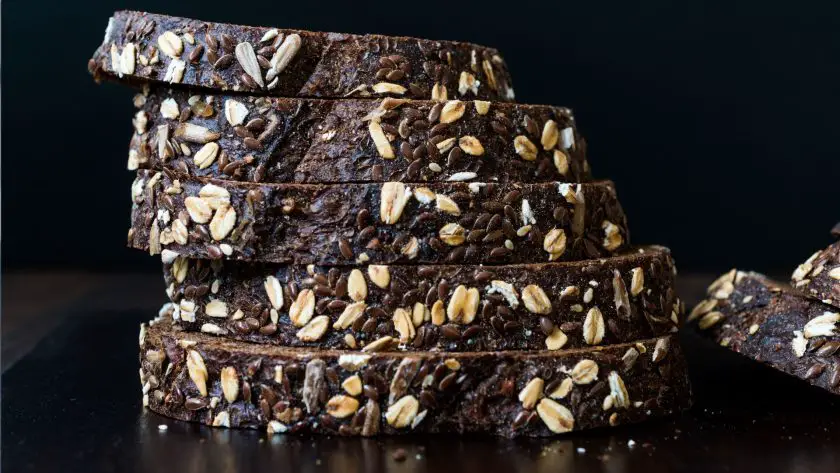
Common Mistakes to Avoid
Overworking the Dough
It’s tempting to vigorously knead away at the shaggy pumpernickel dough in an attempt to force it to come together. However, over-manipulating causes the gluten to become too elastic. This leads to a tough, rubbery texture rather than a nice chewy crumb.
Mix enough that the ingredients stick together. Then let the dough rest for 30 minutes before letting it rise. This gives time for the flour to soak up the liquid for better flavor and texture without overworking the dough.
Proofing at the Wrong Temperature
Pay close attention to proofing your dough in an environment that’s around 70-75°F. Warmer temperatures above 78°F make the yeast overactive leading to blowouts or big air pockets. Cooler conditions below 68°F slow down yeast activity inhibiting rise.
Look for a doubling in size after 1-2 hours. Gently press the surface of the risen dough – it should gradually spring back.
Baking Without Steam
Introducing steam early in the bake helps set the structure so your bread can properly rise. Otherwise, the crust hardens too quickly and prevents the loaf from expanding.
Place an oven-safe pan filled with boiling water on the bottom rack before loading the bread. About 10 minutes in, spray the oven walls with water. Continue steaming for that scrumptious, crackly crust surrounding a soft, moist interior crumb.
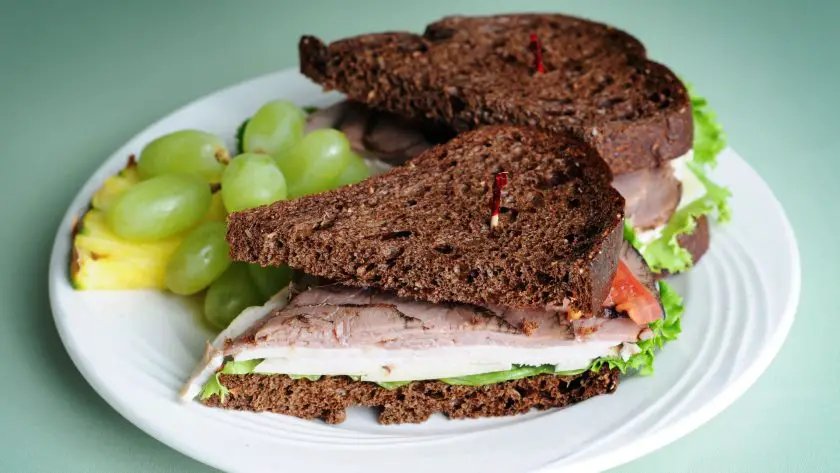
Variations of Pumpernickel Bread
German-Style Pumpernickel
German pumpernickel is crafted from a stiff rye starter dough and baked for up to 24 hours in steam-filled ovens, resulting in an intensely dark loaf with slight woodsmoke undertones.
Seeded Pumpernickel
Try sprinkling in sunflower, caraway, flax or sesame seeds before the second proofing and watch them bloom to the surface during baking. Vary the dough by swapping out some rye flour for buckwheat, spelt or einkorn flour for a multi-textured, seeded sensation.
Old World Charm: Artisanal Pumpernickel Bread
Making pumpernickel bread yourself lets you carry on the tradition of nourishing, hearty loaves. Follow the steps in this recipe to bake the rye dough into delicious loaves. Feel free to add seeds or nuts to make it your own.
Enjoy every tasty slice of your homemade pumpernickel. It will give you energy and comfort to take on your daily challenges.
How To Make Pumpernickel: FAQs
What makes bread pumpernickel?
Pumpernickel bread is made with coarse rye flour and often incorporates rye kernels or cracked rye grains. It uses a sourdough starter instead of yeast to rise, undergoes long baking times, and lacks sugar or oil for a dense texture.
Is pumpernickel the healthiest bread?
Pumpernickel bread is made with coarse rye flour and often incorporates rye kernels or cracked rye grains. It uses a sourdough starter instead of yeast to rise, undergoes long baking times, and lacks sugar or oil for a dense texture.
What is the difference between dark rye and pumpernickel bread?
While dark rye bread contains some colored rye flour, pumpernickel exclusively uses coarse, whole rye grains to achieve its nearly black color, dense texture, and intense rye taste.
What ingredient helps give pumpernickel bread its dark color?
Pumpernickel’s very dark brown-black color comes from the caramelized complex sugars of the whole rye berries used to make the bread, which darkens further through long baking at low temperatures.
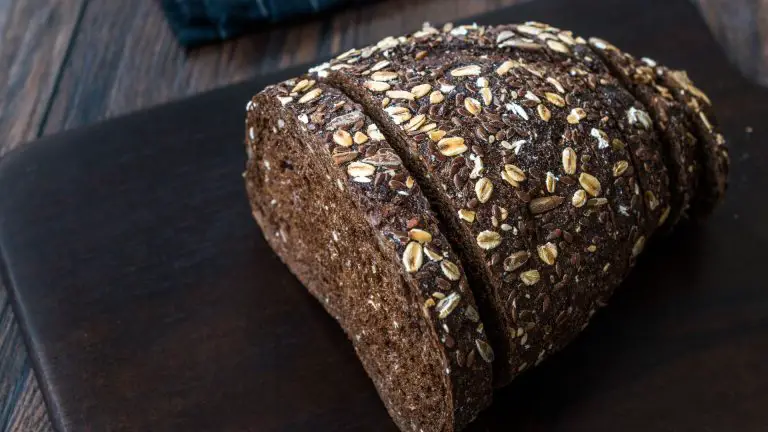
Pumpernickel Bread
This homemade Pumpernickel Bread is perfect with a variety of toppings or as a side to your favorite meals!
- Total Time: 4 hrs 20 mins
- Yield: 1 loaf 1x
Ingredients
- 2 cups dark rye flour
- 1 cup all-purpose flour
- 1 packet (2 1/4 teaspoons) active dry yeast
- 1 tablespoon unsulphured molasses
- 1 teaspoon salt
- 1 1/3 cups warm water (110-115°F)
- 2 tablespoons vegetable oil
- 2 tablespoons cocoa powder
- 1 tablespoon coffee grounds
- 1 teaspoon caraway seeds (optional)
Instructions
Preparation
- Dissolve yeast in warm water (110°F) with a pinch of sugar. Let it sit for 5-10 minutes until frothy.
- In a large mixing bowl, whisk together dark rye flour, all-purpose flour, cocoa powder, coffee grounds, and caraway seeds (if using).
- Add the proofed yeast, molasses, salt, and vegetable oil to the dry ingredients. Mix until a sticky dough forms.
- Turn the dough onto a floured surface and knead for 5-7 minutes, adding more flour as needed. The dough should be tacky but not overly sticky.
- Place the dough in a greased bowl, cover with a damp cloth, and let it rise in a warm place for 1-2 hours, or until doubled in size.
- Punch down the risen dough, shape it into a loaf, and place it in a greased 9×5 inch loaf pan.
- Cover the loaf pan and let the dough rise again for about 30 minutes to an hour.
Baking
- Preheat your oven to 350°F.
- Place the loaf in the oven and bake for 30-40 minutes, or until the bread sounds hollow when tapped.
- Remove the bread from the oven and let it cool in the pan for 10 minutes. Then, transfer it to a wire rack to cool completely.
Notes
- Use stone-ground whole grain rye for a more authentic flavor.
- Blackstrap molasses adds a bittersweet taste.
- Warm the water to the correct temperature to activate the yeast.
- Use Dutch process cocoa for a deeper color.
- Freshly ground coffee enhances the bread’s malty flavor.
- Caraway seeds add an authentic touch but can be omitted.
- Prep Time: 3 hrs 40 mins
- Cook Time: 40 mins
- Category: bread
- Cuisine: German
Nutrition
- Serving Size: 1 slice
- Calories: 160 kcal
- Sugar: 3 g
- Sodium: 200 mg
- Fat: 3 g
- Carbohydrates: 30 g
- Fiber: 4 g
- Protein: 4 g

